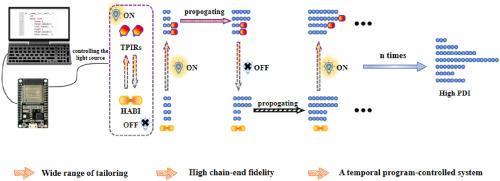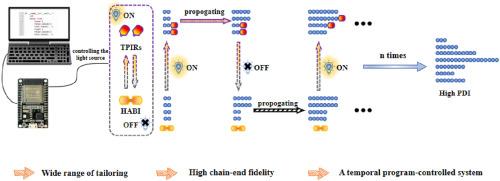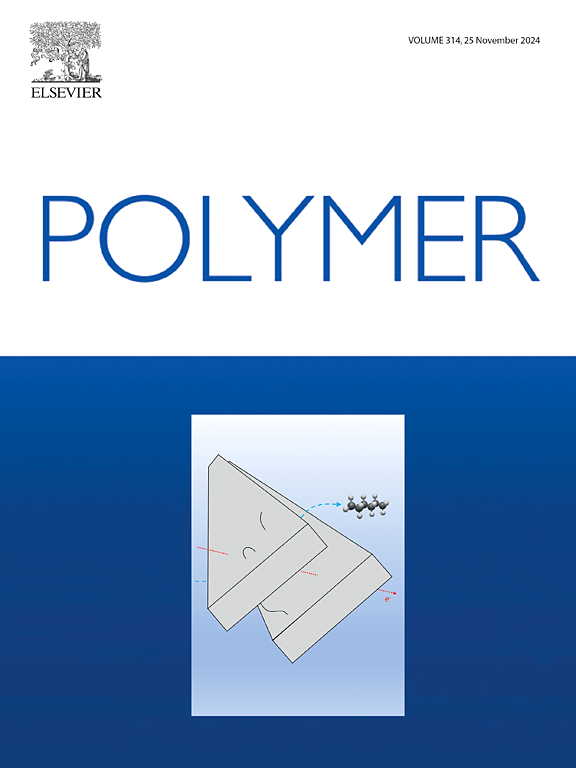用时序程序控制系统通过光致伸缩 RAFT 聚合控制分子量分布
IF 4.1
2区 化学
Q2 POLYMER SCIENCE
引用次数: 0
摘要
聚合物分散指数(PDI)是表征分子量分布的重要指标,对聚合物材料的性能有重大影响。然而,在聚合物合成过程中实现对 PDI 的精确控制仍然是一项巨大的挑战。在本研究中,我们介绍了一种在可切换的可逆加成-碎片链转移自由基聚合(RAFT)中改变聚丙烯酸甲酯(PMA)PDI 的方法。所设计的策略包括利用具有光致伸缩性的六芳基比咪唑(HABI)作为介质,结合时间编程,在整个聚合过程的不同阶段周期性地使传播自由基失活和重新活化。通过计算机控制的单芯片微电脑技术实现了光刺激的精确定时,确保了光学状态的自动调节,减少了操作上的不准确性。通过操纵外部光照条件,PMA 的 PDI 可在 1.80 至 2.59 的范围内进行系统调整。通过成功的延链实验和 MALDI-TOF MS 分析进行验证,证实了采用这种方法制造的不同 PDI 的 PMA 均能保持良好的链端保真度。本文章由计算机程序翻译,如有差异,请以英文原文为准。


Control of molecular weight distribution through photoresponsive RAFT polymerization with a temporal program-controlled system
The polymer dispersity index (PDI) is a vital metric for characterizing molecular weight distribution, significantly influencing polymer material performance. However, achieving precise control over PDI in polymer synthesis remains a substantial challenge. In this study, we introduce an approach for modifying the PDI of poly(methyl acrylate) (PMA) in switchable reversible addition-fragmentation chain transfer radical polymerizations (RAFT). The devised strategy involves the utilization of photoresponsive hexaarylbiimidazole (HABI) as a mediator, coupled with temporal programming, to cyclically deactivate and reactivate propagating radicals at distinct stages throughout the polymerization process. The precise timing of the light stimulus is facilitated through computer-controlled single-chip microcomputer technology, ensuring automatic modulation of the optical state and mitigating operational inaccuracies. By manipulating external light conditions, the PDI of PMAs can be systematically adjusted within the range of 1.80–2.59. Validation through successful chain-extension experiments and analysis via MALDI-TOF MS confirm the preservation of good chain-end fidelity across PMAs with varying PDIs fabricated through this methodology.
求助全文
通过发布文献求助,成功后即可免费获取论文全文。
去求助
来源期刊

Polymer
化学-高分子科学
CiteScore
7.90
自引率
8.70%
发文量
959
审稿时长
32 days
期刊介绍:
Polymer is an interdisciplinary journal dedicated to publishing innovative and significant advances in Polymer Physics, Chemistry and Technology. We welcome submissions on polymer hybrids, nanocomposites, characterisation and self-assembly. Polymer also publishes work on the technological application of polymers in energy and optoelectronics.
The main scope is covered but not limited to the following core areas:
Polymer Materials
Nanocomposites and hybrid nanomaterials
Polymer blends, films, fibres, networks and porous materials
Physical Characterization
Characterisation, modelling and simulation* of molecular and materials properties in bulk, solution, and thin films
Polymer Engineering
Advanced multiscale processing methods
Polymer Synthesis, Modification and Self-assembly
Including designer polymer architectures, mechanisms and kinetics, and supramolecular polymerization
Technological Applications
Polymers for energy generation and storage
Polymer membranes for separation technology
Polymers for opto- and microelectronics.
 求助内容:
求助内容: 应助结果提醒方式:
应助结果提醒方式:


